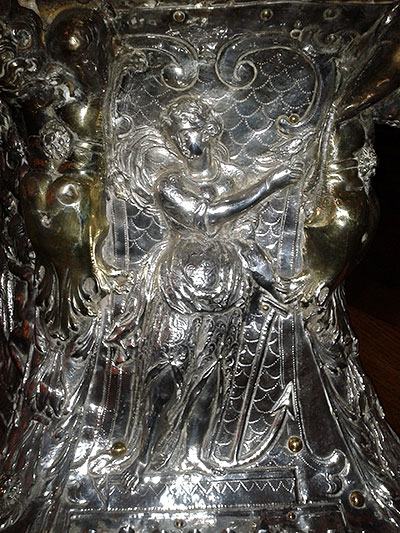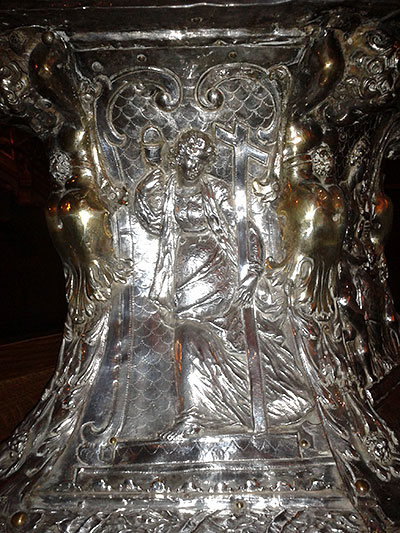Silverware and jewelry in the church of San Saturnino and its chapel of the Virgen del Camino
IGNACIO MIGUÉLIZ VALCARLOS
In the 90s of the twentieth century, in the rooms of the Obrería of the parish of San Saturnino, the chapter of the same decided to enable a small museum conference room where to expose in a dignified and appropriate way part of the trousseau belonging to both the church and the image of the Virgen del Camino. Thus, in cabinets and showcases part of the objects collected by the church throughout its history, pieces of silverware and jewelry that encompass a wide range of time, from the fifteenth to the twentieth century. It is an interesting collection of decorative arts pieces belonging to the parish and to one of the most important dedications venerated in it, Our Lady of the Way. Because Saint Saturnine and the Virgin of the Way are the patron saints of Pamplona, their devotion in the city was very wide, thanks to which they gathered an important trousseau, product of both the adornment of the parish and its chapel by order of the church workers, as well as the donation of objects by the faithful of the images housed in it. Within this group, the pieces of silverware and jewelry stand out above all, pieces that are nothing more than a reflection of what exists, since over the centuries numerous works arrived at the parish, some of which were lost due to their transformation to adapt them to the new fashions, due to deterioration caused by their use, by the sale by the parish or by the alienation, theft or loss as a consequence of the wars that took place from the end of the XVIII century onwards.
Undoubtedly, one of the richest chapters in terms of decorative arts objects preserved in this space is that of silverware, despite the fact that only a small part of what existed has survived to the present day. Already from the Age average the custom was adopted of making in noble metals, mainly silver, the sacred vessels and other objects used in the divine liturgy. From the Renaissance this custom was extended to all churches and all objects related to worship, experiencing a real boom from the Baroque, when any object used in the church was likely to be made in silver. Thanks to this, Spanish churches accumulated a rich collection of silverware, which, however, was largely lost due to the wars that devastated Spain during the 19th century and the ecclesiastical confiscations of the same century.
In the church of San Saturnino a large collection of silver pieces is preserved, ranging from the fourteenth century to the present day, carved both in Navarrese and foreign workshops. However, the most original and richest pieces were carved throughout the centuries of the Age average and the Baroque. One of the oldest works is the reliquary arm of Saint Saturnino, patron saint of the church and patron saint of the city.
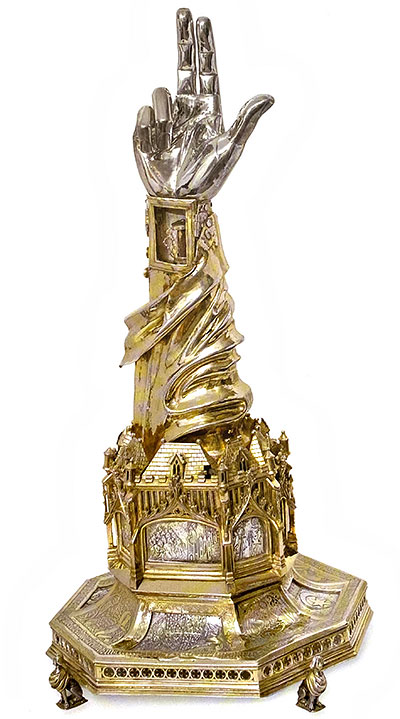
Reliquary of San Saturnino. Anonymous. Pamplona Base, 1389 and Arm. S. XVIII.
This piece, carved in silver in its color and gilded with translucent enamel applications, combines a gothic base from 1389 with an 18th century arm. The octagonal base, supported on four sphinxes, is articulated with a straight plinth with a front of quadrilobed tracery and a warped body that supports an octagonal architectural structure, with articulated fronts through windows of ogee and segmental arches, topped by vegetal cresting, between buttresses, and a polygonal roof with dormers. On this body sits the reliquary arm, of wide and sinuous folds, with a rectangular teak on the wrist and hand in attitude of blessing. Both the base and the architectural body present a rich iconographic decoration of translucent enamel, mostly lost, that in the base arranges the Tetramorphos, symbol of the four evangelists, alternating with four coats of arms with the heraldry of the burgh of San Cernin, in which the church is located, of the bishop of Pamplona Juan de Zalba, next to two of Carlos III, with the arms of Navarre and Evreux, framed by the greyhound and the eagle, currencies of the king, which indicates to us that probably it was a royal donation to San Saturnino. In the architectural body, in the windows located in the fronts, there are scenes of the preaching and martyrdom of the Saint, and in those of the sides, pairs of apostles. Completes this iconography a registration in the base allusive to the relic contained in this piece THIS RELIQUIARY IN WHICH IS THE GLORIOUS POLGAR MARTIR SEYNNNOR SANT SATURNINO OF POMPELONA WHO CONVERTED THE CIEUBDAT OF POMPOLONA TO THE FAITH OF IHESU XRISTU WAS MADE IN THE ANNO M CCC LXXXIX.

Pyxide. Anonymous. Pamplona. Box S. XIV, Astil S. XV and Base and cross S. XVIII.
Also medieval, and with baroque additions, it is a pyx of great development, with a 14th century case, 15th century shaft and 18th century base and cross. It is articulated by means of a circular base with straight plinth and decreasing bodies of convex profile , on which sits a gland and hexagonal shaft, with a knot of galloned apple with four circular kisses. The shaft serves as seat to a prismatic box, finished off by battlements, with conical lid, both dodecagonal, finished off by an apple with a reliquary cross with straight arms finished off in perinolas, framed by angels. The base is decorated with vegetal elements, which are completed with a rich iconography that has figures of fantastic animals in the knot, on the fronts of the box images of the apostles in relief framed in niches of pointed arches, in which the name of the figure that it shelters is inscribed, between buttresses, and on the lid figures of saints incised under trilobed arches.
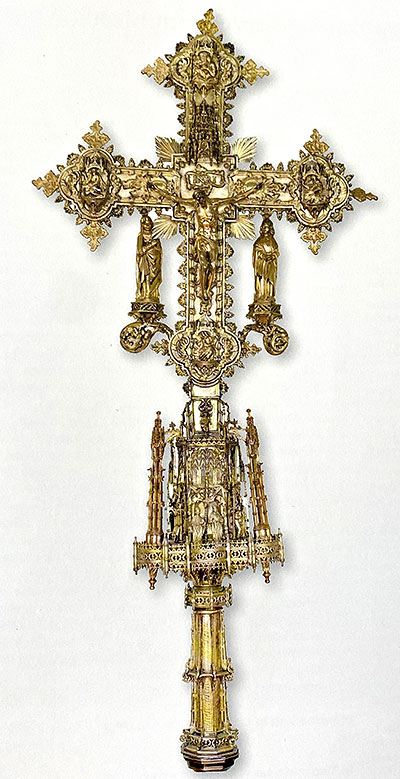
Processional cross. Anonymous. Pamplona. First third of the XVI century, reformed by Pedro Aguinagalde, XVIII century.
The monumental processional cross of the parish church, an emblematic piece within the liturgical trousseau of the churches that led the processions and translated the splendor of the temple, corresponds to the XVI century, prior to 1527 and Gothic style but with decoration of rococo taste product of a later reform. It is a work carved in gilded silver, with a cylindrical barrel, a polygonal architectural temple of two bodies, and a Latin cross with straight arms with flordelisado ends and square quadron. It presents a variegated decoration articulated in the mace by means of openwork tracery, buttresses, flying buttresses and gables, and in the tree of the cross by vegetal elements, rockery crests and beveled rays product of the eighteenth-century reform. It is completed with a rich iconography arranged in the architectural knot, in the terminations of the arms and in the quadron. Thus, in the fronts of the macolla are located, in pairs, the figures of St. Paul and St. John, St. Thomas and St. James, a holy bishop and St. Catherine, St. Andrew and St. Bartholomew, placing in the upper part a naked child and a holy deacon. The front square is presided over by the Crucified Christ, framed by the figures of the Virgin and St. John, placed on two lateral leafy candlesticks, and the seated evangelists at the ends; while, on the back square is St. Saturninus framed at the ends by the Fathers of the Latin Church: St. Augustine, St. Jerome, St. Gregory the Great and St. Ambrose. It is stamped with the mark of Pamplona -PPLON- used in the city from 1423 to approximately 1560, although it lacks a stamp of authorship, so we do not know the author of this work. In 1780 it was reformed, but maintaining its style, by the Pamplona silversmith Pedro de Aguinagalde. It is one of the most important crosses of the Pamplona silversmith of the 16th century. Another cross is preserved in the parish, belonging to the XVII century, of simpler typology, with cylindrical barrel, apple knot and Latin cross of straight arms with widening and oval ends, undoubtedly used for minor ceremonies.

Our Lady of the Way. S. XII. Detail of the silver covering of the back of the throne. 1720-1721.
Curiously, there are few preserved pieces corresponding to the 16th century and Renaissance models, despite the fact that, thanks to documentation, we know of numerous commissions and that this is the most original period of Pamplona silverware. From this period it is worth mentioning some chrysmeras in the form of a chest, a traditional typology in the Pamplona workshop, with hermas in the angles and moresque decoration similar to that used in his works by the silversmith Luis de Suescun. During the Baroque period, the peak and splendor of Navarrese silversmithing, both the church of San Saturnino and the chapel of Nuestra Señora del Camino were richly decorated. From this time, from 1720-1721, is the silver covering that was made to the image of the Virgin, a Romanesque carving from the second half of the 12th century that was reformed to convert it into a vestment image, covering the image and the silver throne, the latter with a variegated incised decoration of plant motifs that frames the Crucifixion on the back. Later, in 1848, a new reform was carried out, in which besides intervening in the face, arms and hands of the Virgin, the original medieval Child was replaced by another one of silver, keeping the remains of the first one inside the new image.
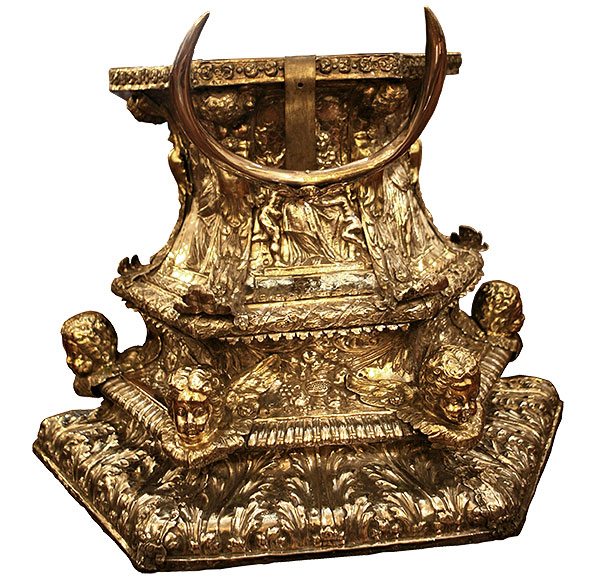
Virgen del Camino's pedestal. Daniel Gutiérrez and Hernando Yavar. Pamplona. 1701.
|
|
|
Pieces of great interest are the throne and pedestal on which Our Lady of the Way sits, the former made in 1720-1721, when, as we have seen, the wooden image of the Virgin was covered in silver, and the latter in 1701. Both works are stamped several times with the mark of Pamplona used at this time, the double P crowned and bordered with chains, although they lack the stamp of authorship. Thanks to the preserved documentation, we know that the pedestal was made by the silversmiths Hernando Yavar and Daniel Gutiérrez, commissioned by the San Saturnino workshop. The trapezoidal base, designed to be attached to the wall and profile truncated truncated truncated pyramid-shaped, is articulated by means of three decreasing concave bodies separated from each other by two flying moldings, the first one with a crown and the second one imitating fasces. The lower body is formed by large acanthus leaves, the central one by vegetal garlands from which fruits hang, with large golden cherub heads in the corners, and the upper one by the figures in relief of the theological virtues: Faith, Hope and Charity, framed by stipes formed by torsos of angels topped by vegetal elements superimposed on large flying acanthus leaves. These three images complete the cardinal virtues that are represented in the main altarpiece of the chapel, which shelters the image, alluding to the virtues that adorn Our Lady.
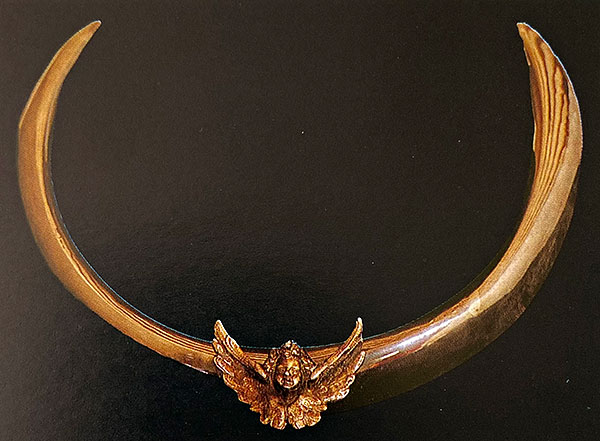
average moon. Anonymous. Mexico. 1675.

Throne of the Virgin of the Way. Anonymous. Pamplona. 1721.
From this third body hangs a average moon of large dimensions, silver, smooth and with a cherub in the central part, reference letter to the apocalyptic image Tota Pulchra and the figure of the Immaculate Conception, sent from Mexico by Juan de Cenoz, treasurer of Yucatan in 1675, as indicated in the registration that presents THIS average SILVER MOON OFFERED TO OUR LADY OF THE WAY JUAN DE CENOZ TREASURER OF THE PROVINCE OF JUCATAN BY HIS MAGD 1675. On the pedestal is placed the throne on which the Virgin sits, usually hidden under the dresses worn by the image. It is formed by a polygonal base with straight plinth and truncated truncated truncated pyramidal body of warped walls, decorated with vegetal elements that frame oval mirrors with Marian emblems, followed by a large flattened spherical body that simulates a cloud with cherubs.
There is an abundance of preserved shaft pieces, chalices, ciboria and monstrances, although in the case of the former they are very simple pieces, where the functional is more important than the decorative, as was the case in Navarre's Baroque silverware. In spite of the fact that this was a time of splendor and splendor, in the shaft pieces, simple forms inherited from the past were maintained for the most part, with a greater richness in the more decorative typologies, of which no examples had been made in previous centuries. One of the preserved chalices was donated to the church, possibly on the occasion of the inauguration of the chapel of the Virgen del Camino, by the Brotherhood of silversmiths of San Eloy, which had its headquarters in the temple, as indicated in the registration that presents DADIVA DE LA HERMANDAD DE PLATEROS DE PAMPNA A N.RA S.A DEL CAMINO. AUGUST 24, 1776. It is a piece in gilded silver, with circular base of decreasing bodies of profile truncated cone, shaft with ajarronado knot strangled between concave bodies separated by flying rings, and bell-shaped cup that differentiates subcopa of profile mixtilíneo. It presents a variegated decoration of rocailles, vegetal elements and pairs of cherubs that covers the piece completely, except for the cup, which at the base inscribes Christological themes, the lamb on the book of the seven seals, the pelican with its young and the empty tomb.
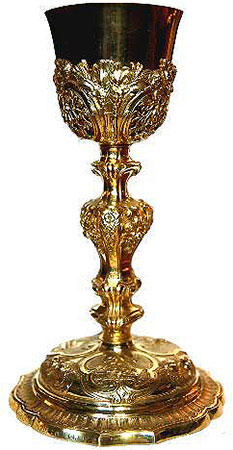
Chalice. Anonymous. Pamplona. 1776.

Chalice. Anonymous. Viceroyalty of New Spain (Mexico). End of XVII century.
Interesting is a chalice of Mexican origin, and known as the Amescoas, due to the registration that presents: AMESCVA. It is a work made of gilded silver in the late seventeenth century, consisting of a circular base of decreasing bodies, with two straight bodies framing a convex one, the latter with alternating decoration of coffered ceilings and cherub heads. Cylindrical neck and shaft with vase knot and upper bull, followed by a balustraded body that gives way to the cup, flared and with fretworked and trimmed sub-cup formed by eight large palmettes flown with cherub heads. sample The decoration is articulated by straight ribs, coffers, cherub heads, ribs in ce, handles, gadroons and vegetal palmettes, as well as chopped vegetal elements of luster that are distributed by the different bodies without altering the architectural rhythm of the piece. Thanks to the registration and to the preserved documentation, we know that it was donated by a member of the Amescoa family around 1698-1699, together with a few wine cruets and some blandones, now lost.

Custody. Anonymous. Viceroyalty of Peru (Potosí, Bolivia). 1734.

Custody. Anonymous. Pamplona. 1570-1580.

Custody. Anonymous. Pamplona. First third of the seventeenth century.

Custody. Anonymous. Pamplona. Second quarter of the seventeenth century.
Baroque are also four rich monstrances that are kept in this trousseau, standing out among them one from Potosí, present-day Bolivia and formerly part of the Viceroyalty of Peru. It is a work made of gilded silver with silver overlays in its color, which follows the traditional models of monstrance of this viceroyalty, articulated by means of a square base, cylindrical neck, shaft with vase knot framed by several cylindrical and balustraded bodies, and ostensory of circular molded virile and variegated burst of alternating rays with cherubs. It presents an exuberant decoration based on vegetal elements, Solomonic columns, ribs, caes, braces and tufted cherubs that mask the architectural structure of the piece. This ornamentation is completed by the figures of the four evangelists located on the neck. This piece has a singular history, since it was originally sent in 1734 by Pedro Navarro, a resident of the viceroyalty, to Juan Antonio Navarro, his cousin who was a priest in Santa María de Olite, where he arrived in 1745. From this temple it was alienated during one of the conflicts of the XIX century, being bought by Melchor de Irisarri, parish priest of the church of San Saturnino, as it indicates the registration that presents: PROPERTY OF D MELCHOR IRISARRI PARROCO DE S SATURNINO DE PAMPLONA, bequeathing it to this church at the time of his death in 1865.
The elegance of the other three monstrances preserved in the church, which are three variants of the same model made throughout the sixteenth century, is not to be underestimated. The first of the pieces, carved in gilded silver around 1570-1580 and with a sun added in the 18th century, is articulated by means of an oval base with decreasing bodies, a knotted knot and an ostensory with straight rays, topped with stars, alternating with bevels. It presents a variegated decoration on the base and the knot articulated by means of twisted leather, masks and vegetal garlands. The second, in silver and gilded bronze, carved in the first third of the XVII century, sample square base with lugs on the fronts, straight base and convex upper body followed by another of trapezoidal shape that gives way to the shaft. This presents a knot of architectural templete framed by cups and templetes, that give way to the ostensory, with double circular viril molded with a burst of straight and alternating beveled rays, finished the exterior by a Latin cross of rhomboidal arms finished in perinolas. The ornamentation of the piece is articulated on the basis of the succession of architectural bodies that compose it, on which are arranged handles and ribs in ce, and that is completed in the body of the base by means of ribs, palmettes and vegetal garlands of great fleshiness, and in the rest of bodies by means of chopped scales of luster. The following monstrance, carved in gilded silver in the second quarter of the seventeenth century, is articulated by a circular base of decreasing bodies, cylindrical neck of great development, shaft with vase knot followed by cup, all between cylindrical bodies, and ostensory of double circular virile molded with a burst of straight and beveled rays, on the outside with alternate cherubs with rhinestones in the molding of the virile and stars culminating the straight rays, topped by cross. It presents a decoration of great sobriety that in the base and in the shaft is made up of vegetal elements, ribs and coffered panels, and in the ostensory, of precious stones and cherubs.

Reliquary of San Felipe Neri and San Saturnino. Pamplona. Reliquary. Anonymous. 1740 and Base and shaft, Miguel de Zildoz. End of XVIII century.
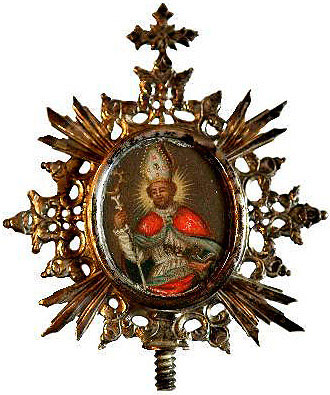
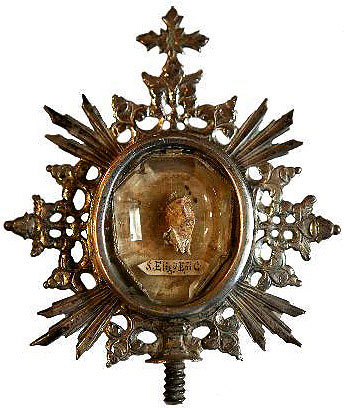
Reliquary of Saint Eloy. Luis de Odri. Pamplona. 1722.
Following the models of the sun monstrance, several reliquaries are preserved that can be coupled to a base and shaft of common use, such as the one made by Miguel de Zildoz at the end of the 19th century. It is a circular base, silver in its color, articulated by means of decreasing bodies and by a convex body between straight flanges followed by a carved body. The shaft has a succession of concave bodies and convex bulls, framing a vase knot with an upper convex bull of profile periform. It is stamped with the punch of the aforementioned silversmith, ZIL/DOZ. Among the monstrances that can be attached is the reliquary of St. Saturninus and St. Philip Neri, of oval teak, molded and fluted surrounded by a glory of alternating beveled rays with opposing C-spikes and vegetal elements, the upper one topped by a vegetal cross. The obverse side of the teak inscribes the relics of Saint Saturninus and Saint Philip Neri, as indicated by the accompanying cartouches. Meanwhile, the reverse presents a silver plate engraved with the registration S. Saturnyno i S. Phelipe Neri stamped with a crown and framed by palms alluding to the martyrdom. These relics appear for the first time in the inventory of goods of the parish of 1737, in two bronze reliquaries, indicating in the one of 1740 that they have been placed together in a silver reliquary, which would correspond to the one studied here. In the inventory of 1777 it is mentioned that the reliquary lacks a base, although it is noted that in the parish church there are two feet that are used with different reliquaries. The reliquary of Saint Barbara or Saint Eloy, belonging to the old Pamplona silversmiths' guild, made in gilded silver by Luis de Odri as an exam to gain access to the Degree of master silversmith in 1722, corresponds to the same outline . It is a reliquary of subject ostensory, with a straight oval teak framed by a burst in which triple beveled rays alternate with others formed by opposing C's and vegetal elements, topped by a Greek cross with vegetal arms. The obverse shows the image of St. Eloy painted on a tin leaf and on the reverse, a relic of the Saint framed by the registration S. Eligii Epi. C. Reliquaries without foot are also multiple pieces of gothic style, in gilded silver, of profile rhomboidal, articulated by means of a polygonal fanal of horizontal section framed in the superior and inferior part by two triangular bodies with decoration of tracery that inscribe a central tondo. Or the Renaissance style double reliquary donated to the church by Doña Beatriz de Icart and Doña Beatriz de Beaumont, her daughter, who had also paid for the main altarpiece of the Dominicans of Pamplona, the pantheon of her parents.
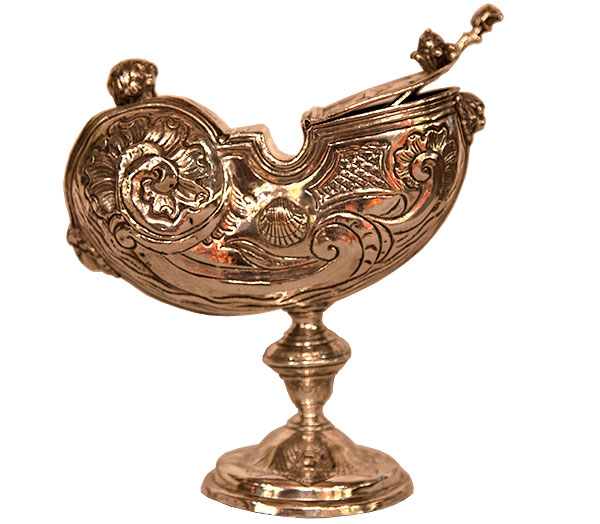
Naveta. Pedro Aguinagalde. Pamplona. 1790.
A naveta carved in 1790 by Pedro Aguinagalde, the same silversmith who had repaired the processional cross, belongs to the last third of the 18th century. It has a polylobed foot of profile flared, a shaft with an inverted periform knot and a nautilus-shaped body. It is covered by a rich decoration, which is articulated by means of cherub heads and rockeries of great development, scallops and frames with rhomboidal grid, completed in the cover of the bow with the coat of arms of the burgh of San Cernin: a six-pointed star on a average moon.
Several pieces of civil typology are also preserved, works of greater rarity since they were generally sent to the crucible to be melted, either for economic needs of the owner's family, or with the intention of making new and more fashionable jewelry with their materials. In fact, a great part of the civil baroque works existing today in Navarre have been preserved in religious institutions due to their donation to the different temples and images of devotion by their owners.

Salvilla. Miguel de Amasa. Pamplona. 1697.
Among the pieces conserved in San Saturnino, a pair of salvillas stand out that, although they formally remind us of Gothic style works, they present an ornamentation based on vegetal elements of a Baroque character. The mark, a double P crowned with a border of chains, used in Pamplona between 1652 and the first quarter of the 18th century, corroborates this ascription, as well as the fact that these pieces exactly repeat the design made by Miguel Amasa in 1697 as an examination drawing to obtain his approval as a master silversmith.
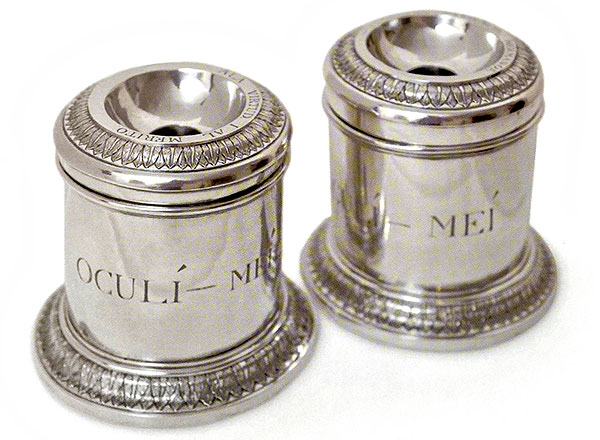
Ballot boxes of the Brotherhood of Oculi Mei. Pamplona. Manuel Montalbo. 1793.
Of great interest are also a pair of voting urns of the Brotherhood of Oculi Mei, silver in its color, made by the Pamplona silversmith Manuel Montalbo in 1793, as can be seen thanks to the marks that it presents, a double crowned P, used in Pamplona in the last two decades of the eighteenth century and during the nineteenth century, and MONT/ALB, corresponding to that silversmith, accompanied by a third chronological punch, 93. This is a highly original typology, as no other examples have been preserved in Navarre, except for the voting urns of the Diputación de Navarra, of a different format. Pieces of great simplicity, they are articulated by means of a straight cylindrical pot with a molded mouth and lower part, of greater diameter, with a straight plinth and palm-leaf molding. The lid is formed by decreasing moldings, the outer ones are straight and the central one is made of palm leaves, with a circular oculus in the central part to introduce the vow. On the front of the jar both show the registration OCULI MEI, name of the Major Confraternity of San Saturnino, allusive to the words with which the Mass began on the third Sunday of Lent, called Sunday of Oculi Mei, the day in which the chapter of the Confraternity met. Meanwhile, in the upper molding of the cover one inscribes PACIENCIA PACIENCIA HERMANOS, and the other A LA VIRTUD I AL MERITO, allusive to virtues that should adorn the confreres, and that on the other hand were framed within the virtues that every man should have and, especially, the good Christian.
We end the tour of the church's silverware with the pieces corresponding to the 19th century, which follow models of greater sobriety and functionality. The origin of these pieces is to be found in the new needs that were created in the parish throughout the nineteenth century, since the seizures produced during the wars of the nineteenth century made it necessary to replace many pieces, which were generally more sober than those they came to replace. Likewise, new uses in the liturgy and the ceremonial of the parish made it necessary to make ad hoc pieces. And finally, as had happened throughout history, gifts and donations continued to be received from the faithful and devotees. As in the preceding centuries, the most numerous typology among the pieces conserved in San Saturnino is the chalice, of which there are several examples, those corresponding to the first half of the century of great simplicity, following neoclassical models, while in the second half of the century they gain in decorativism due to the fact that they respond to historicist models.
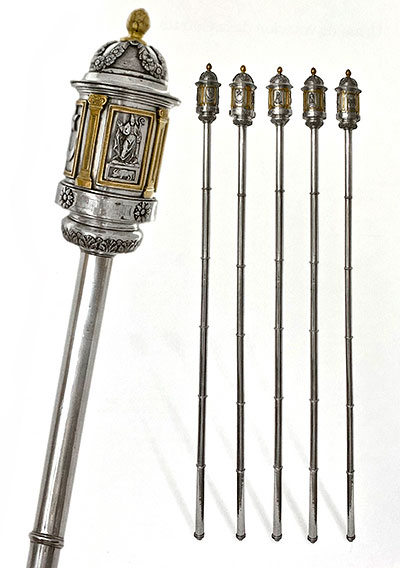
Scepters. Pedro Antonio Sasa. Pamplona. 1826.
From this time is also a set of six scepters, of silver in its color and gilded brass, made by the Pamplona silversmith Pedro Antonio Sasa in 1826, at a cost of one hundred and eighty reales fuertes each. These pieces were made to replace previous ones that had been lost during the War of Independence, and they were to be recurrent in the parishes of Pamplona, as all of them were to be equipped with this type. They are neoclassical pieces of architectural subject composed of a cylindrical rod and a head in the form of a circular templete, topped by a hemispherical dome ending in an artichoke. The main body is compartmentalized in four fronts by means of composite pilasters, which frame four rectangular windows in which the figures in relief of the Virgin of the Way and Saint Saturnino are inscribed, next to the coat of arms of the burgh of San Cernin, and a panoply with the attributes of the saint: mitre, crosier, book, pectoral cross and palm of martyrdom.
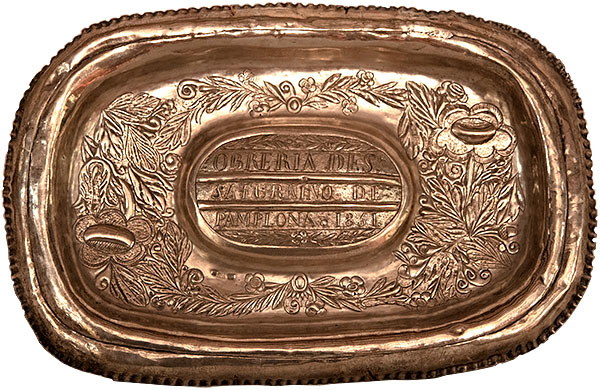
Tray. Vicente Sasa. Pamplona. 1861.
As occurred in previous centuries, also at this time, civil silverware typologies arrived to the parishes of Pamplona, sample of which are several trays, one of which, dated 1861, presents the field decorated with flowers and plant elements framing the button, with horizontal moldings in which is arranged the registration OBRERIA DE SN, SATURNINO DE, PAMPLONA. 1851, indicative that it was owned by that workmanship. It is a work made by the Pamplona silversmith Vicente Sasa, as we can see thanks to the marks that it presents, the one of authorship corresponding to the mentioned silversmith, SASA, and the double PP crowned of Pamplona.
The figure of Our Lady of the Way, co-patron saint of Pamplona together with Saint Saturnino, was probably the Marian image of the city that attracted the most followers, even ahead of Santa María la Real or the Sagrario, patron saint of the cathedral. Because of this, it received numerous donations of pieces of jewelry, which is recorded in the documentation preserved in the chapel. However, few pieces have come down to us, since after the construction of the chapel in the 18th century, the custom was adopted of raffling the jewels donated to Our Lady, except those necessary for its ornamentation, in order to raise funds to pay for the construction and decoration of the chapel, as well as other later works. Because of this, at present the image of Our Lady has very few jewels, the most important being a crown and rostrillo, a breastplate and a brooch in the shape of a average moon.
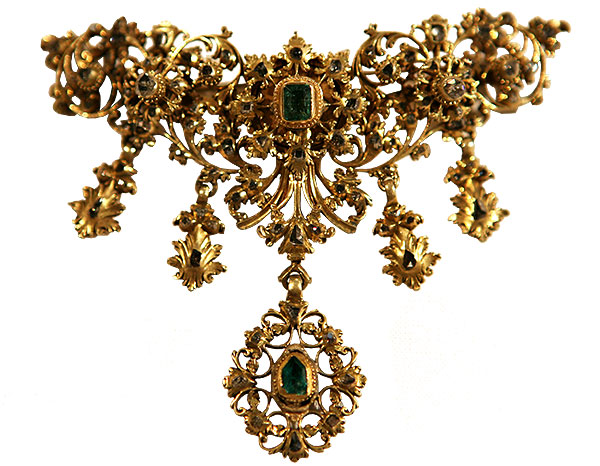
Dungarees. Anonymous. Pamplona. First third of the eighteenth century.
The oldest piece of jewelry is a bib from the first third of the eighteenth century, made of gold, openwork and cut, with rose-cut diamonds and emeralds. Of triangular profile , it is articulated by means of a central button surrounded by palmettes flowers, all set with emeralds, which expands on the sides by means of vegetal scrolls, set with diamonds. From the central body hangs an almond, while from the sides hang lanterns, the first set with emeralds and the second with diamonds This piece was probably not auctioned with the other jewels of the Virgin because it was confused with a ribbon given in 1738 by Queen Mariana of Neoburg (1667-1740), widow of Charles II (1661-1700), who resided for a few months in Pamplona after her return to Spain. " His Majesty, by his own hand, has placed a diamond jewel of his royal use on the said holy image, which, in addition to its great value for the esteem of the parish, was the alaja of his royal person". The documentation of the chapel constantly records this piece individually, which was appraised by the silversmith José de Yavar at 12,000 reales, "a silver jewel in the form of a ribbon with a gilded reverse with sixty-one grown diamonds, the fifty-five roses, four bottoms and the remaining tables that were given and placed by her hand to Our Lady by the Queen, the widow Mariana de Neoburg".

Dungarees. Anonymous, France? Mid 18th century.
These models also respond to a silver and rhinestone bib from the mid-eighteenth century that is currently incorporated in the daily rostrillo of the Virgin. The strass, a glass paste that when solidified can be cut, resembling the diamond and getting pieces of great showiness and low price, was very fashionable in mid-century. This material was invented by Joseph Strass, an Austrian goldsmith who worked for the French court, and was used to make abundant costume jewelry throughout the eighteenth century.

Brooch. Harvey Jewelry. Biarritz. France. Second half of the nineteenth century.
From the second half of the nineteenth century is a brooch in the form of average moon-shaped silver and gold views set with diamonds in the air. It is a piece of great simplicity and beauty of which we do not know the authorship, although it is kept in a case of the Harvey jewelry store in Biarritz, which could well be the original. However, it is a common and popular model in the jewelry of the second half of the nineteenth century, so probably local jewelers would also make pieces of this subject.
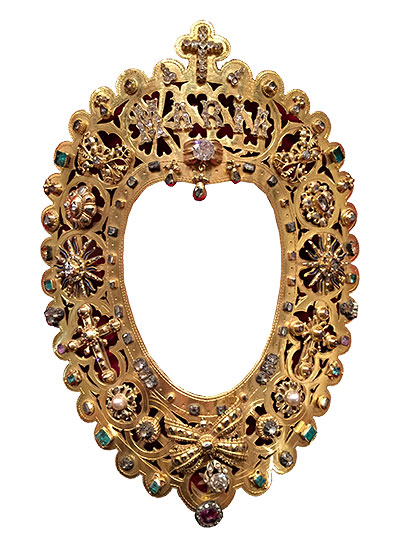
Rostrillo. Esteban García. Pamplona. 1914. Jewelry pieces of the Ss. XVIII and XIX.
To the XX century it belongs a gold rosette that incorporates pieces of different epochs belonging to the Virgin. It was made in 1914 by the silversmith Esteban García from Pamplona, when Francisco González Viscarret was the parish priest of San Saturnino. It is considered to be the rich rostrillo of Our Lady of the Way, the one used in the great festivities. Among the pieces that we see incorporated in this work we find three small bows, two crosses, two buttons, earrings and rings of gold and diamonds, work of the second third of the eighteenth century, as well as earrings, gold and diamond rings, enamels of the nineteenth century, along with a sign with his name in brilliant and loose rhinestones, diamonds, emeralds and amethysts, incorporated forming a symmetrical and harmonious design .
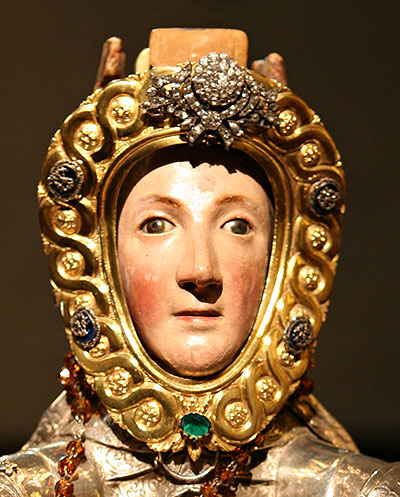
Rostrillo. Anonymous. Pamplona. Early twentieth century.
Our Lady of the Way has a second rostrillo of greater simplicity, also from the early twentieth century, usually used by the image, made of gilded silver, which incorporates the aforementioned rhinestone bow, as well as a series of blue and silver translucent enamel buttons in their nineteenth-century color and a green stone.

Crown of the Child. Esteban García. Pamplona. Early twentieth century.
Esteban García is also the author of a crown for the Child that holds the Virgin in her arms, carved in gold with rose-cut diamonds and emeralds, which is articulated by a straight ring framed by moldings, in which are set, alternately, buttons of diamonds and emeralds, on which sits a row of pearls and diamonds, and a crest formed by large fleurs-de-lis and the heraldic emblem of the parish, a average moon surmounted by six-pointed stars, set with diamonds.
file parish of San Saturnino. Books of conference proceedings of the Obrería de San Saturnino and various papers of the Chapel of Nuestra Señora del Camino.
ARDANAZ IÑARGA, N., "protocol y ceremonial del Cabildo pamplonés en el siglo XVIII: Estancia de la reina viuda, Mariana de Neoburgo en Pamplona (1738-1739)", in R. Fernández Gracia and M.ª C. García Gainza (Coords.), programs of study sobre la catedral de Pamplona "in memoriam" Jesús M.ª Omeñaca, Cuadernos de la Chair de Patrimonio y Arte Navarro, n.º 1, Pamplona, University of Navarra, 2006, pp. 411-431.
ECHEVERRÍA GOÑI, P. L., "Mecenazgo y legados de Indianos en Navarra", in Segundo congress General de Historia de Navarra, Pamplona, Príncipe de Viana, Anexo 13, 1991.
FERNÁNDEZ GRACIA, R., (Coord.), Pamplona y San Cernin. 1611-2011. IV Centenary of the vow of the city, Pamplona, Pamplona City Council, 2011.
GARCÍA GAINZA, M.ª C., Dibujos antiguos de los plateros de Pamplona, Pamplona, University of Navarra, 1991.
GARCÍA GAINZA, M.ª C. et al., Catalog Monumental de Navarra. Merindad de Pamplona. Volume V***, Pamplona, Government of Navarra - Archbishopric of Pamplona - University of Navarra, 1998.
GARCÍA GAINZA, M.ª C. and FERNÁNDEZ GRACIA, R. (Coords.), Juan de Goyeneche y el triunfo de los navarros en la monarquía hispánica del siglo XVIII, Madrid-Pamplona, Fundación Caja Navarra, 2005.
HEREDIA MORENO, M.ª C. and ORBE SIVATTE, M., Orfebrería de Navarra 1. Edad average, Pamplona, Caja de Ahorros de Navarra, 1986.
HEREDIA MORENO, M.ª C., ORBE SIVATTE, A. and ORBE SIVATTE, M., Arte hispanoamericano en Navarra, Pamplona, Príncipe de Viana, 1992.
MIGUÉLIZ VALCARLOS, I., "El joyero de la Virgen del Sagrario en los siglos del Barroco", in R. Fernández Gracia and M.ª C. García Gainza (Coords.), programs of study sobre la catedral de Pamplona "in memoriam" Jesús M.ª Omeñaca, Cuadernos de la Chair de Patrimonio y Arte Navarro, n.º 1, Pamplona, Universidad de Navarra, 2006, pp. 227-257.
MIGUÉLIZ VALCARLOS, I., "The treasure of San Fermín. Donación de Alhajas al Santo a lo largo del siglo XVIII", in R. Fernández Gracia and M.ª C. García Gainza (Coords.), Promoción y mecenazgo del arte en Navarra. Cuadernos de la Chair de Patrimonio y Arte Navarro, n.º 2, Pamplona, 2007, pp. 297-320.
MIGUÉLIZ VALCARLOS I., Joyería en Navarra. 1500-1900, Pamplona, Chair de Patrimonio y Arte Navarro, 2019.
MOLINS MUGUETA, J. L. and FERNÁNDEZ GRACIA, R., "La capilla de Nuestra Señora del Camino", in La Virgen del Camino de Pamplona. IV Centenary of its appearance (1487-1997), Pamplona, Mutua de Pamplona, 1987, pp. 61-117.
MORALES SOLCHAGA, E., "Dos piezas argénteas de la Cofradía de San Eloy de los plateros en la iglesia de San Saturnino de Pamplona", in La pieza del mes. classroom abierta. Chair de Patrimonio y Arte Navarro, October 2019.
ORBE SIVATTE, A., Platería del reino de Navarra en el siglo del Renacimiento, Pamplona, Government of Navarra, 2000.
ORBE SIVATTE, M., Platería en el taller de Pamplona en los siglos del Barroco, Pamplona, Government of Navarra, 2008.
VVAA, Philippines, Gateway to the Orient. From Legazpi to Malaspina, San Sebastian, 2004.

